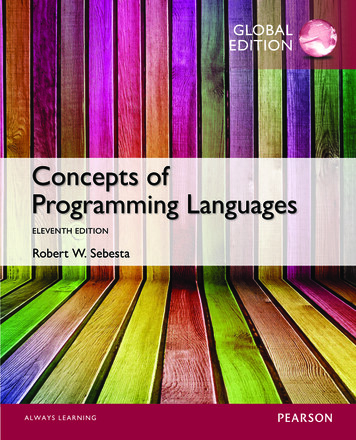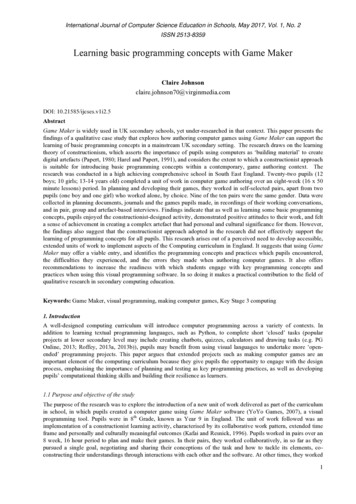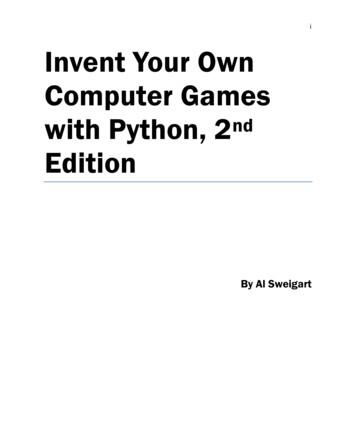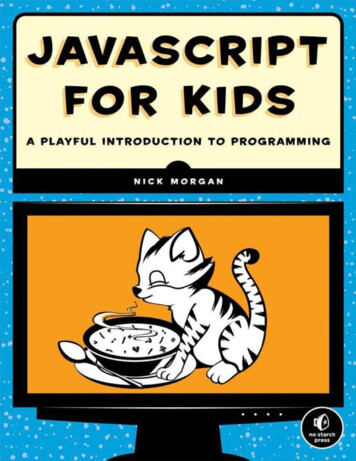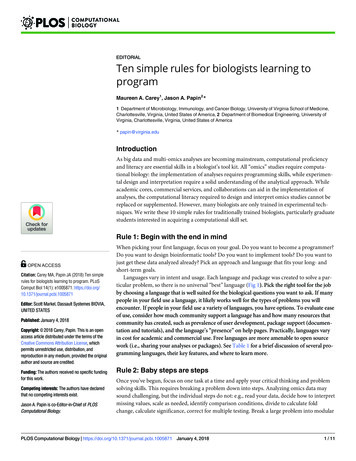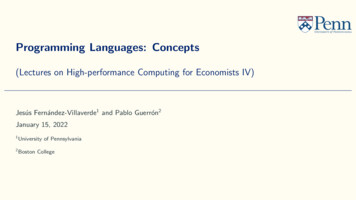
Transcription
Programming Languages: Concepts(Lectures on High-performance Computing for Economists IV)Jesús Fernández-Villaverde1 and Pablo Guerrón2January 15, 20221University of Pennsylvania2Boston College
Introduction
Motivation Since the invention of Fortran in 1954-1957 to substitute assembly language, hundreds ofprogramming languages have appeared. Some more successful than others, some more useful than others. Moreover, languages evolve over time (different version of Fortran). Different languages are oriented toward certain goals and have different approaches. Our thinking about what is a good programming language has also changed as we accumulate moreexperience with computers.1
2
Some references Programming Language Pragmatics (4th Edition), by Michael L. Scott. Essentials of Programming Languages (3rd Edition), by Daniel P. Friedman and Mitchell Wand. Concepts of Programming Languages (11th Edition), by Robert W. Sebesta. http://hyperpolyglot.org/3
The basic questions Which programming language to learn? Which programming language to use in this project? Do I need to learn a new language?4
Which programming language? I Likely to be a large investment. Also, you will probably want to be familiar at least with a couple of them (good mental flexibility)plus LATEX.Alan PerlisA language that doesn’t affect the way you think about programming is not worth knowing. There is a good chance you will need to recycle yourself over your career.5
Which programming language? II Typical problems in economics can be:1. CPU-intensive.2. Memory-intensive. Imply different emphasis. Because of time constraints, we will not discuss memory-intensive tools such as Kubernetes andSpark.6
Classification
Classification There is no “best” solution. But there are some good tips. We can classify programming languages according to different criteria. We will pick several criteria that are relevant for economists:1. Level.2. Domain.3. Execution.4. Type.5. Paradigm.7
Level Levels:1. machine code.2. Low level: assembly language like NASM (http://www.nasm.us/), GAS, or HLA (The Art of 64-BitAssembly, by Randall Hyde).3. High level: like C/C , Julia, . You can actually mix different levels (C). Portability. You are unlikely to see low level programming unless you get into the absolute frontier ofperformance (for instance, with extremely aggressive parallelization).8
9
Fibonacci numberMachine code:8B542408 83FA0077 06B80000 0000C383 FA027706 B8010000 00C353BB01000000 B9010000 008D0419 83FA0376 078BD98B C84AEBF1 5BC3Assembler:ib: mov edx, [esp 8] cmp edx, 0 ja @f mov eax, 0 ret @@: cmp edx, 2 ja @fmov eax, 1 ret @@: push ebx mov ebx, 1 mov ecx, 1 @@: lea eax, 3 jbe @f movebx, ecx [ebx ecx] cmp edx, mov ecx, eax dec edx jmp @b @@: pop ebx retC :int fibonacci(const int x) {if (x 0) return(0);if (x 1) return(1);return (fibonacci(x-1)) fibonacci(x-2);}10
Domain Domain:1. General-purpose programming languages (GPL), such as Fortran, C/C , Python, .2. Domain specific language (DSL) such as Julia, R, Matlab, Mathematica, . Advantages/disadvantages:1. GPL are more powerful, usually faster to run.2. DSL are easier to learn, faster to code, built-in functions and procedures.11
Execution I Three basic modes to run code:1. Interpreted: Python, R, Mathematica.2. Compiled: Fortran, C/C .3. JIT (Just-in-Time) compilation: Julia, Matlab. Interpreted languages can we used with:1. A command line in a REPL (Read–eval–print loop).2. A script file. Many DSL are interpreted, but this is neither necessary nor sufficient. Advantages/disadvantages: similar to GPL versus DSL. Interpreted and JIT programs are easier to move across platforms.12
Execution II In reality, things are somewhat messier. Some languages are explicitly designed with an interpreter and a compiler (Haskell, Scala, F#). Compiled programs can be extended with third-party interpreters (CINT and Cling for C/C ). Often, interpreted programs can be compiled with an auxiliary tool (Matlab, Mathematica,.). Interpreted programs can also be compiled into byte code (R, languages that run on the JVM -bydesign or by a third party compiler). We can mix interpretation/compilation with libraries.13
Types I Type strength:1. Strong: type enforced.2. Weak: type is tried to be adapted. Type expression:1. Manifest: explicit type.2. Inferred: implicit. Type checking:1. Static: type checking is performed during compile-time.2. Dynamic: type checking is performed during run-time. Type safety:1. Safe: error message.2. Unsafe: no error.14
Types II Advantages of strong/manifest/static/safe type:1. Easier to find programming mistakes ADA, for critical real-time applications, is strongly typed.2. Easier to read.3. Easier to optimize for compilers.4. Faster runtime not all values need to carry a dynamic type. Disadvantages:1. Harder to code.2. Harder to learn.3. Harder to prototype.15
Types III You implement strong/manifest/static/safe typing in dynamically typed languages. You can define variables explicitly. For example, in Juliaa 10::Int It often improve performance speed and safety. You can introduce checks:a "This is a string"if typeof(a) Stringprintln(a)elseprintln("Error")end16
17
18
Language popularity I C family (a subset of the ALGOL family), also known as “curly-brackets languages”:1. C, C , C#: 26.41%: 3 out of top 5.2. C, Java, C , C#, JavaScript: 39.16%: 5 out of top 10. Python: position 1, 13.58%. R: position 12, 1.25%. Matlab: position 16, 0.96%. Fortran: position 19, 0.77%. Julia: position 28, 0.39%.19
Language popularity II High-performance and scientific computing is a small area within the programming community. Thus, you need to read the previous numbers carefully. For example:1. You will most likely never use JavaScript or PHP (at least while wearing with your “economist” hat) ordeal with an embedded system.2. C# and Swift are cousins of C focused on industry applications not very relevant for you.3. Java (usually) pays a speed penalty.4. Fortran is still used in some circles in high-performance programming, but most programmers will neverbump into anyone who uses Fortran.20
Multiprogramming Attractive approach in many situations. Best IDEs can easily link files from different languages. Easier examples:1. ccall and PyCall in Julia.2. Rcpp.3. Mex files in Matlab.21
Essentials of Programming Languages (3rd Edition), by Daniel P. Friedman and Mitchell Wand. Concepts of Programming Languages (11th Edition), by Robert W. Sebesta. . Scala, F#). Compiled programs can be extended with
